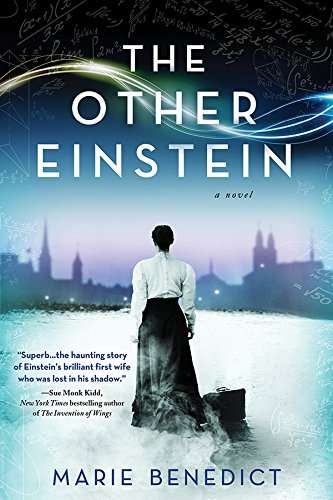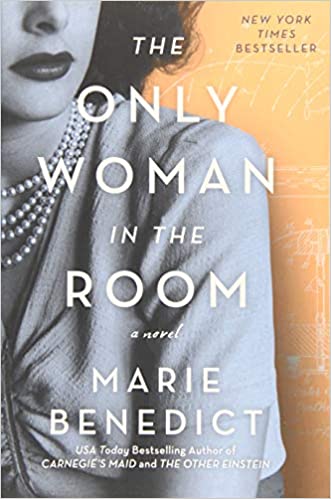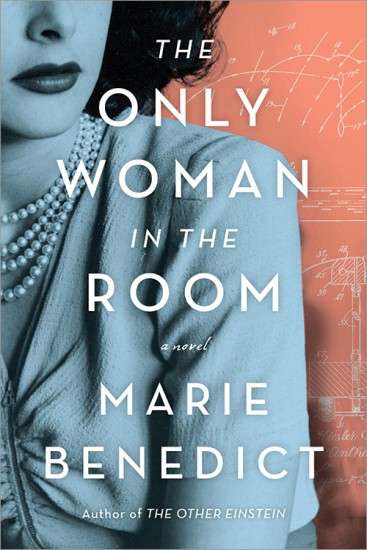The Only Woman in the Room by Marie Benedict
An actress, inventor, and keeper of secrets, the beautiful Hedy Lamarr was among many Jews who fled Europe during the 1930s and came to Hollywood to start a new life. Born in Vienna in 1914, she studied acting with the innovative theater director, Max Reinhardt. But she made the mistake of appearing nude in Ecstasy, a 1933 silent Czech film, and never quite shed the sex goddess stereotype. When Hedy died in 2000, The New York Times noted that her life had been “messy and sad.”
In her newest novel, The Only Woman in the Room (Sourcebooks Landmark), Marie Benedict tells a vibrant, nuanced story about the ambitious actress. The only daughter of assimilated Jews, Hedy made a bargain with the devil by marrying an Austrian arms dealer named Fritz Mandl who would, she believed, protect her from the Nazis. But he turned out to be a brutal man and a fascist who encouraged Hitler to launch the Anschluss in 1938.
By that time, however, Hedy had fled to London where she contrived a meeting with the powerful movie producer, Louis B. Mayer. From there she proceeded to California and five more husbands and several children, and starred in films with Robert Taylor, Clark Gable, Victor Mature, and Spencer Tracy.
Hedy’s thrilling escape from Fritz might seem like the climax of the story. But when the U.S. enters the war and the Holocaust comes to dominate the news, Hedy feels anguished guilt about not sharing crucial military information that she overheard at Mandl’s dinner table back in Vienna. It is here that Benedict portrays the actress at her very best, as a co-inventor of spread-spectrum technology, which would, Hedy proposed, enable the Navy to manipulate radio frequencies and thus prevent the jamming of codes. Readers will be fascinated by Hedy’s mastery of scientific theories as well as her ingenuity and persistence, as Benedict winds up with the glamorous actress once again upon a stage before a rapt audience.
BookTrib recently conducted a Q&A with the author, who provided more insights into her work.
Claudia Keenan: There are so many ways to interpret the book’s intriguing title. Is it perhaps a reference to the years when Hedy was married to Fritz and sat at her own dining table, the sole woman among scheming autocrats?
Marie Benedict: The title was selected specifically because it has so many meanings, not unlike Hedy’s own life. In one respect, I viewed it as a reference to Hedy’s years on Fritz’s arm, the only woman among many men, listening intently as the military men and arms dealers behind World War II discussed their plans, oblivious to the fact that this beautiful woman was gathering their secrets. But I also intended for the title to refer to her work as a scientist creating the secret communications system to improve the Allies’ war at sea (an invention we use every day with wifi), the only woman scientist in a field of men whose work is rejected, in part, because of her gender. These are issues women in all fields still deal with today.
CK: The plot contains echoes of a fairy tale – a beautiful maiden trapped in a castle, attempting to flee her evil husband. Do you think that Hedy’s story has a fantastic quality?
MB: Hedy’s entire life seemed to have a fantastical quality, on the outside at least. From her youthful career as an actress (including filming one of the first nude scenes in a movie) to her life with arms manufacturer Fritz Mandl living in castles to her years as a film star in Hollywood, she seemed to have an existence tinged with fairy tale qualities. But this narrative existed only on the exterior. Hedy’s interior life was much richer and nuanced and complicated, and this part of her story is the focus of the book. The authentic stories of women’s lives are usually more intriguing — and messy — than the stories the world packages for them.
CK: Hedy’s encounters with the lecherous producer Louis B. Mayer and her resistance to the advances of various other men evoke the #MeToo movement. Do you think she was ahead of her time?
MB: The writing of the scenes between Hedy and Louis B. Mayer has an interesting story of its own. I drafted those scenes — the first, when Hedy meets Louis for her initial “interview” in a hotel room, and the second, when Hedy is propositioned by Louis at a party — months before the Harvey Weinstein scandal broke. When I reread those scenes afterwards as part of my editing process, I could not believe the uncanny similarity they bore to the accounts of so many modern-day victims. In this respect, I don’t believe so much that Hedy was ahead of her time as that the issues historical women face are the same ones contemporary women continue to face. But her resistance — and her success with that resistance — was modern.
CK: Like The Only Woman in the Room, your novel The Other Einstein involves scientific research. You write so fluidly about math and physics. Is science a special interest of yours?
MB: Only as an adult — and as a writer — have I come to appreciate the beauty in math and science. I attribute this new-found enjoyment to the historical  women I write about — Mileva Maric Einstein and Hedy Lamarr, in particular. Growing up, I found both topics daunting, and I was not encouraged to push myself in them, because they were “boy” subjects, after all. But when I viewed math and science through the eyes of Mileva and Hedy, I saw those subjects anew, as a lens through which to examine at the world, and I began to view them almost poetically and naturally, as they did.
women I write about — Mileva Maric Einstein and Hedy Lamarr, in particular. Growing up, I found both topics daunting, and I was not encouraged to push myself in them, because they were “boy” subjects, after all. But when I viewed math and science through the eyes of Mileva and Hedy, I saw those subjects anew, as a lens through which to examine at the world, and I began to view them almost poetically and naturally, as they did.
CK: Did Hedy actually have a complicated relationship with a distant mother?
MB: I’m drawn to excavating the unknown stories of historical women whose lives have modern-day meaning, like that of Hedy Lamarr. I write historical fiction instead of non-fiction, in part, so that I can fill in the research gaps with the logic I developed during my decade-long career as a commercial litigator in New York City — and there are lots of gaps because, until recently, women’s stories weren’t considered worthy of preserving. Understanding Hedy’s relationship with her mother must deal with, in part, that research gap. While the biographical materials suggest that she had a close relationship with her father, but that she and her mother were prickly in their dealings, we do not have an abundance of details. We know that her mother was not effusive in her praise of Hedy and wanted a more traditional existence for her, but that Hedy did go to great lengths to protect her mother after the Anschluss and bring her to America. In terms of the rest, therein lies the fiction.
CK: Your novels have been set in a wide swath of the 19th and 20th centuries. Do you have an especially favorite era?
MB: In selecting stories to share, I gravitate toward specific women rather than specific eras. Historical women have made so many contributions to our modern society — of which we are often unaware — and I am drawn toward narratives that reveal the way in which those women’s lives reverberate into the present. That said, it is somewhat easier to identify those women in eras in closer proximity to our own, and the period of the World Wars — in which the line between good and evil can sometimes be starkly drawn — contains some particularly powerful women’s narratives.
CK: Are you at work on a new novel?
MB: There are too many women’s stories to stop writing! I am currently working on a novel about Clementine Churchill. While Winston is often hailed as one of the great leaders of the modern era, little is known about his wife. But this incredible, strong woman — a believer in the suffragette ideals and a force in her own right — played an enormous role in her husband’s work, and key British officials from the time have speculated whether the outcome of World War II would have been the same without her. And yet, she struggled with many of the same issues that modern-day women do, making hers a critical historical story and a contemporary one as well.
The Only Woman in the Room is available to purchase January 15th.
RELATED POSTS
“Lady Clementine:” The Powerful Woman Behind Winston Churchill
Buy this Book!
Amazon





